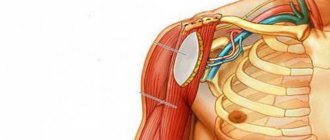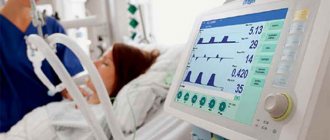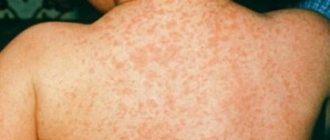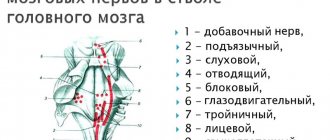Bulbar and pseudobulbar syndrome: what it is, photos, causes and treatment of the disorder
As a result of disruption of the functioning of certain elements of the brain, a person may develop pseudobulbar syndrome (cranial nerve damage syndrome).
The mechanism of the pathological condition is based on a disruption of the activity of nerve cells located in the medulla oblongata. Despite the fact that the problem significantly reduces a person’s quality of life, it does not pose a significant threat to his health. Timely detection and subsequent differential diagnosis of syndromes with a similar clinical picture allows the doctor to select adequate therapeutic measures.
How to diagnose the disease?
Diagnosis of this disease does not include a huge number of tests and instrumental treatment methods. The basis is an external examination of the patient by a specialist, as well as a procedure such as electromyography.
Electromyography is the study of bioelectric potentials that arise in human muscles when muscle fibers are excited.
Based on the data obtained, the doctor makes a conclusion and prescribes treatment.
Diagnostics
A neurologist prescribes diagnosis and treatment of bulbar palsy. First of all, the specialist conducts a neurological examination and electromyography. Based on the diagnostic results, the doctor identifies the cause of bulbar syndrome and prescribes treatment. The specialist must determine the breathing rate and heartbeat.
The following studies are carried out for bulbar palsy:
- Radiography makes it possible to detect fractures and bruises of the head, and tumor processes.
- Electromyography helps check the performance of the muscles of the tongue, neck, arms, and legs. This type of diagnosis reveals muscle activity in a calm state and during contraction.
- Esophagoscopy. This research method helps to examine the esophagus. The performance of the pharynx muscles and vocal cords is assessed.
- Magnetic resonance imaging. A fast and high-quality diagnostic method that detects various diseases in 90% of cases. MRI makes it possible to evaluate the condition of all organs. Tomography helps identify brain pathologies. The study is most often carried out using a contrast agent.
- Electrocardiogram. Makes it possible to find different heart diseases and study heart rhythm.
- Laboratory tests are carried out to identify inflammatory processes, infections, and hemorrhage. A general analysis of urine, blood and cerebrospinal fluid examination is prescribed.
When performing computed tomography and MRI, tumor formations, edema, and cysts are detected in the brain. If the first symptoms of bulbar palsy appear, you should immediately visit a doctor. The disease only progresses over time and cannot be avoided without treatment. the disease can be fatal.
To confirm pseudobulbar syndrome, differential diagnosis should be made from bulbar syndrome, neuroses, parkinsonism and nephritis. One of the most important signs of the pseudoform of the disease is the absence of muscle atrophy.
It should also be noted that the syndrome is similar in its characteristics to Parkinson-like paralysis. The patient, as with pseudobulbar disorder, experiences speech impairment and violent crying. This pathology proceeds slowly, and in the final stages leads to apoplexy strokes. That is why it is important to seek help from a qualified and experienced doctor as early as possible.
Causes
The bulbar nerves are affected due to neurological development. This leads to changes in the central nervous system. When motor nerve endings are affected, peripheral paralysis occurs.
The following causes of bulbar syndrome are observed:
- a stroke that affected the medulla oblongata,
- infectious head disease,
- malignant and benign tumor processes,
- multiple sclerosis,
- bruises and fractures of the base of the skull,
- inflammation in the brain
- blood supply disturbance,
- botulinum toxin intoxication.
It often happens that the cause of bulbar palsy is hypertension. The disease worsens the patient's condition over time. Against this background, atherosclerosis develops, vascular spasm occurs, and this leads to a stroke, which is why bulbar syndrome occurs.
If you feel unwell, you should consult a doctor. If bulbar symptoms are ignored, various complications can occur.
Mechanism of occurrence
If the main parts of the nervous system are damaged, human life is supported by the autonomous functioning of certain elements. Their work is not regulated by the cerebral cortex.
These elements are neurons. Their independent activity leads to the fact that complex motor acts (breathing, swallowing, speech) are carried out with disturbances.
Coordinated activity of different muscle groups is possible only with the clearest possible coordination in the work of different parts of the brain. The autonomous functioning of subcortical structures cannot ensure this.
When the higher sections cease to regulate the motor nuclei (a collection of nerve cells) located in the medulla oblongata, a person develops pseudobulbar syndrome.
The absence of a “manager” activates the operation of the cores in autonomous mode.
Such isolated activities have the following consequences:
- complete preservation of the functioning of vital systems of the body (cardiovascular and respiratory);
- paralysis of the soft palate leads to impaired swallowing;
- speech becomes unintelligible;
- inactivity of the vocal cords and impaired phonation.
Spontaneous contraction of the facial muscles leads to the appearance of grimaces that imitate various emotional situations.
Understanding the development process of any disease allows doctors to promptly and promptly select an effective treatment regimen.
If the main parts of the nervous system are damaged, human life is supported by the autonomous functioning of certain elements. Their work is not regulated by the cerebral cortex. These elements are neurons. Their independent activity leads to the fact that complex motor acts (breathing, swallowing, speech) are carried out with disturbances.
photos of people with bulbar syndromes
This syndrome occurs as a result of damage to the neural pathways through which information from the cerebral cortex enters the nuclei.
In the vast majority of cases, the main causes of this disorder may be the following conditions:
- hypertension (high blood pressure), which favors the development of ischemic and hemorrhagic stroke;
- the presence of atherosclerotic plaques in the arterioles of the brain;
- circulatory disorders caused by unilateral damage to the blood vessels supplying the brain;
- traumatic brain injuries of various types;
- vasculitis arising from diseases such as tuberculosis or syphilis;
- brain injury during childbirth;
- metabolic disorders with long-term use of drugs containing valproic acid;
- malignant neoplasms and benign tumors in the frontal lobes or subcortical structures;
- inflammation of brain tissue caused by diseases of infectious etiology.
Pseudobulbar syndrome mainly develops as a result of many chronic processes that are at the stage of progression. Acute oxygen starvation is a factor that also contributes to the development of this unpleasant condition.
How to understand that it is bulbar syndrome?
Bulbar syndrome is manifested by characteristic signs of damage to the cranial nerves. There are three characteristic symptoms indicating the development of bulbar palsy:
- Dysphagia or impaired swallowing process.
- Dysarthria or impairment of articulate speech.
- Aphonia is a disturbance in the sound of speech.
Characteristic manifestations of bulbar syndrome:
- paresis of half the tongue;
- deviation of the tongue towards the affected side;
- folding of the mucous membrane gradually appears;
- sagging of the velum;
- deviation of the uvula also in the direction of the lesion;
- the patient's palatal and pharyngeal reflexes disappear;
- the swallowing process is disrupted, liquid food may enter the respiratory tract or nose;
- Some patients experience increased salivation and drooling;
- speech disorder.
A patient with bulbar syndrome has difficulty swallowing solid food. Liquid food can enter the respiratory tract because the innervation of the soft palate is impaired. These patients have an increased risk of developing pneumonia.
Due to a violation of the innervation of the tongue, the patient’s speech becomes inarticulate. He speaks nasally, “in the nose.” He has difficulty pronouncing the sounds “l” and “r”. The voice becomes dull and hoarse.
The disease causes paresis of the muscles of the tongue, upper palate, larynx, and pharynx. Often a unilateral lesion develops. The occurrence of bilateral paralysis indicates damage to the neuronal nuclei in the medulla oblongata. Such a lesion is life-threatening for the patient.
Bulbar palsy in children
For pediatric practice, the pseudobulbar form is most significant.
Children with pseudobulbar disorder often stay in auxiliary schools. because its external manifestations are so severe that they force doctors and teachers to send children without intellectual problems only because of speech to special schools, and sometimes even to social security institutions.
From the neurological side, this form has a complex picture: together with central paralysis of the muscles of the speech apparatus, the baby experiences changes in muscle tone, hyperkinesis, and other movement disorders.
The complexity of the disease also determines the characteristics of its manifestations.
This form of deviation in children is usually a manifestation of cerebral palsy, which often appears before 2 years of age due to brain diseases. Cerebral palsy is often a consequence of trauma during childbirth.
Motor impairments in these children are widespread.
The upper part of the face is often affected, causing it to become immobile and there is general awkwardness and clumsiness. Parents notice that the baby cannot take care of himself and does not actively move.
All non-speech functions involving the tongue, lips and other parts of the speech apparatus are also impaired: the child has difficulty chewing food, swallowing, and cannot swallow or retain saliva.
Bulbar syndrome
Bulbar dysarthria occurs when there is inflammation or formation of the medulla oblongata.
In this case, the nuclei of the motor cranial nerves located there die.
Characterized by paresis of the muscles of the pharynx, tongue, and soft palate.
A child with this disorder has difficulty swallowing food and has difficulty chewing.
Low mobility of the vocal folds causes speech disorders. No voiced sounds are heard in speech. Paresis of the muscles of the palate leads to easy passage of exhaled air through the nose, and all sounds have a nasal connotation.
In children with this form of deviation, the muscles of the tongue and pharynx die. Speech is unclear and slow. The face of a baby with bulbar dysarthria is motionless.
Bulbar palsy develops in unborn children. There is strong moisture in the oral mucosa; in normal conditions it should be almost dry. If you examine the baby's mouth when he is crying, you will notice that the tongue is slightly turned to the side. This sign appears when the hypoglossal nerve ending is disrupted.
Bulbar syndrome in children occurs in rare cases, since it involves damage to the brain stems. They cease to function, and life without them is impossible. Pseudobulbar palsy often occurs in children and is extremely difficult. The baby suffers not only from loss of speech, but also from changes in muscle tone.
Hyperkinesis and various disorders of the motor system may also develop. This leads to cerebral palsy. The disease can begin to affect newborns and children under two years of age. Most often, cerebral palsy occurs due to birth injuries.
With bulbar syndrome, the child experiences impaired motor skills. It happens that the upper facial part is damaged, which causes immobility. The child does not have the opportunity to take care of himself. Such children look clumsy, have difficulty chewing and swallowing food, and keep drool in their mouth. Proper treatment for bulbar palsy must be prescribed.
In addition to the main cause of the syndrome, attention should also be paid to normalizing the functioning of neurons and improving blood circulation in the brain (Aminalon, Encephabol, Cerebrolysin). Metabolic, vascular, nootropic (“Nootropil”, “Pantogam”) and acetylcholine-breaking agents (“Oxazil”, “Proserin”) will help cope with the disease.
Unfortunately, there is no single drug for the treatment of paralysis yet. The specialist must draw up a specific set of therapy, taking into account all the existing pathologies in the patient. Moreover, in addition to drug treatment, it is necessary to add breathing exercises, exercises for all affected muscles, and physiotherapy.
Also, in case of incorrect pronunciation of words, patients should take a course of classes with a speech pathologist. This therapy will be especially useful for children. This will make it easier for the child to adapt to school or another educational institution.
The chances of improving your health will increase significantly if you use stem cells to treat your illness. They are capable of triggering the replacement of the myelin sheath, which will lead to restoration of the functioning of damaged cells.
If pseudobulbar palsy occurs in a newborn child, it is necessary to begin comprehensive treatment as soon as possible. It usually includes: feeding the child through a tube, massage of the mouth muscles and electrophoresis in the cervical spine.
We can talk about improving the general condition of the baby only when the child begins to develop reflexes that were absent before; the neurological condition is stabilized; there will be positive changes in the treatment of deviations that were previously established. Also, the newborn should increase motor activity and muscle tone.
When incurable lesions are not detected in a newborn, usually the recovery process begins already during the first two weeks of the baby’s life. If pseudobulbar palsy is detected, treatment occurs in the fourth week and necessarily requires rehabilitation. For children who have suffered seizures, doctors select medications especially carefully. Cerebrolysin is usually used (about 10 injections). And to maintain the body, Phenotropil and Phenibut are prescribed.
As an additional therapy that will speed up the process of recovery and rehabilitation, specialists prescribe therapeutic massage and physiotherapy.
The massage should be performed strictly by a professional and have a predominantly tonic and sometimes relaxing effect. Even children can carry out such procedures. If a child has spasticity of the limbs, it is better to start procedures already on the tenth day of life. The optimal course of therapy is 15 sessions. At the same time, it is recommended to take the Mydocalma course.
Physiotherapy usually involves magnesium sulfate electrophoresis with aloe applied to the cervical area.
This is one of the neuralgic disorders that is a consequence of pseudobulbar palsy. The disease occurs due to disruption of the pathways that connect the bulbar pulp to the brain. Pathology can have 3 degrees:
- Easy. Almost invisible, characterized by unclear pronunciation of many sounds in children.
- Average. The most common. Almost all facial movements become impossible. It is uncomfortable for patients to swallow food, and the tongue is inactive. Speech becomes slurred and unclear.
- Heavy. The patient cannot control his facial expressions, and the mobility of the entire speech apparatus is impaired. Patients often have a drooping jaw and a stiff tongue.
Treatment of pathology is only possible through a combination of medications, massage and reflexology at the same time. The syndrome poses a huge danger to human life, so delaying treatment is highly discouraged.
Causes of the disease
Bulbar disorders are manifested by paralysis of the muscles of the pharynx, epiglottis, tongue, lips, soft palate, and vocal cords. Such changes occur due to disruption of brain activity, namely the medulla oblongata.
For accurate diagnosis and subsequent treatment of bulbar syndrome, which could give high positive results, it is important to establish the causes of the development of pathology.
Among the factors, experts name the following:
- hereditary;
- vascular;
- degenerative;
- infectious.
Infectious causes of bulbar syndrome lie in acute intermittent porphyria and Kennedy bulbospinal amyotrophy. The degenerative factor occurs when a person develops syringobulbia, polio, and Guillain-Barre syndrome.
Those who have suffered an ischemic stroke are also at risk. Common causes of the disease include amyotrophic sclerosis, paroxysmal myoplegia, and spinal amyotrophy Fazio-Londe.
We should not forget about the danger for humans of post-vaccination and paraneoplastic polyneuropathy and hyperthyroidism, because these pathologies can also lead to the appearance of symptoms of bulbar syndrome.
Among other causes of the syndrome, experts also name the following diseases and processes:
- botulism;
- spinal cord tumor;
- bone abnormalities;
- meningitis;
- encephalitis.
Thus, many factors can provoke the emergence of such a dangerous pathology in a person’s life. Only a group of highly qualified specialists can establish these causes with maximum accuracy using modern diagnostic methods and tools.
Symptoms of bulbar syndrome
The development of a disease caused by brain damage can be recognized by its characteristic signs. It is important to distinguish between bulbar and pseudobulbar syndromes, the symptoms of which are slightly different.
The following symptoms are characteristic of bulbar palsy:
Symptoms may vary in severity for each person. Pseudobulbar, or false paralysis, occurs with bilateral brain damage.
Clinically, these two disorders manifest themselves with the same symptoms, only with pseudobulbar palsy, atrophy, a reaction of degeneration and twitching of the tongue do not develop. In addition, pseudobulbar syndrome, unlike bulbar syndrome, does not lead to respiratory and cardiac arrest.
How does the disease progress in children?
With the development of bulbar syndrome in newborns, there is increased moisture in the oral mucosa, which normally should be relatively dry. If you look into the baby's mouth while screaming or crying, you will find that the tip of the tongue is slightly retracted to the side. This symptom occurs when the hypoglossal nerve is damaged.
In children, bulbar palsy is rarely observed, since it affects the brain stems, without which life becomes impossible. More often, children develop pseudobulbar palsy, which clinically manifests itself very severely. In addition to paralysis of the muscles of the speech apparatus, the child also experiences changes in muscle tone, hyperkinesis and other movement disorders.
This form of brain stem damage in newborns is often a manifestation of cerebral palsy. Pathology can appear immediately after birth or in children under two years of age. Quite often, cerebral palsy becomes a consequence of birth injuries.
With bulbar and pseudobulbar syndromes, parents notice motor impairment in the child. The upper part of the face is often affected, causing it to become immobile.
Such children are unable to care for themselves, they look clumsy and awkward, they cannot chew and swallow food normally, and they cannot retain saliva in their mouth.
How is the treatment carried out?
The health of people with this pathology needs to be given special attention. Often, urgent medical attention is required to save the patient's life. Our main actions are to neutralize the threat to the patient’s life until he is hospitalized and treated. Typically, support is required for body functions that have been impaired due to damage to the brain stems.
To do this, specialists carry out the following actions:
- artificial ventilation to restore breathing;
- the use of Proserin, adenosine triphosphate and vitamins to activate the swallowing reflex;
- prescription of Atropine to reduce salivation.
Symptomatic treatment is required to alleviate the patient's condition. It is also important to cure the disease that caused the development of bulbar syndrome.
Bulbar syndrome refers to a pathology of cranial nerves, when not a single nerve is affected, but a whole group: glossopharyngeal, vagus and hypoglossal, the nuclei of which are located in the medulla oblongata.
Clinical symptoms
A characteristic feature of pseudobulbar syndrome is the fact that patients suffering from this disorder may laugh or cry against their own will.
The process of swallowing and articulation are disrupted, and various grimaces appear on the face.
Due to the fact that the muscles of the palate and pharynx are weakened, swallowing is preceded by a tickling sensation and the appearance of slight pauses. There is no atrophy or twitching of the affected muscles.
Damage to the cranial nerves often results in speech impairment, with only pronunciation affected. Blurred articulation is combined with a dull voice.
The appearance of forced laughter or involuntary crying is caused by a short-term spasm of the facial muscles. Such behavior is absolutely unrelated to the emotional impressions suffered and is carried out involuntarily.
Pseudobulbar syndrome is not an isolated disease. This disorder is mainly accompanied by some other neurological disorders.
The clinical picture and the degree of its severity are largely determined by the main reason that activated the pathology. If the frontal lobes are affected, the syndrome manifests itself as symptoms of an emotional-volitional disorder. The patient may experience apathy, loss of interest in what is happening around him, poor activity or lack of initiative.
Impaired motor functions appear if elements of the subcortical zone are damaged. The main task of doctors is to correctly differentiate the relatively harmless pseudobulbar syndrome from a life-threatening bulbar disease.
A characteristic feature of pseudobulbar syndrome is the fact that patients suffering from this disorder may laugh or cry against their own will. The process of swallowing and articulation are disrupted, and various grimaces appear on the face. Due to the fact that the muscles of the palate and pharynx are weakened, swallowing is preceded by a tickling sensation and the appearance of slight pauses. There is no atrophy or twitching of the affected muscles.
The appearance of forced laughter or involuntary crying is caused by a short-term spasm of the facial muscles. Such behavior is absolutely unrelated to the emotional impressions suffered and is carried out involuntarily. Often there are symptoms indicating a violation of voluntary movements of facial muscles. It is for this reason that if the patient is asked to close his eyes, he may open his mouth.
Bulbar and pseudobulbar syndromes have many similar symptoms and signs, since the common feature of these disorders is the effect on one muscle.
But if pseudobulbar deviation occurs when there is a disorder of the central motor neuron. then bulbar - when a peripheral neuron is damaged. That is, pseudobulbar palsy is central, and bulbar palsy is peripheral.
Accordingly, in the clinic of pseudobulbar disorder, the main thing is an increase in muscle tone, the occurrence of unhealthy reflexes and the absence of muscle atrophy.
In the bulbar clinic, the main factors are muscle weakness, the appearance of muscle twitching, the death of muscle tissue, and the absence of reflexes.
Manifestations of both types of lesions simultaneously occur in amyotrophic lateral sclerosis.
Symptoms
There are several types of bulbar syndrome. The acute form of the pathology passes quickly and develops against the background of a stroke, swelling or contusion of the brain, or encephalitis. If the disease is progressive, then bulbar palsy occurs slowly.
It occurs against the background of various pathologies that are associated with the central nervous system. Most often this is Kennedy amyatrophy, tumor formations in the brain. Bulbar syndrome can be bilateral or unilateral. The pathology is often reflected in the movements of the larynx, tongue, and pharynx.
There are three signs that appear with bulbar palsy:
- Dysphagia is when swallowing is impaired. The patient has difficulty swallowing food due to progressive paralysis of the soft palate. A weak patient may easily choke on food. Over time, progressive bulbar palsy develops, and the patient has difficulty eating even soft foods.
- Dysarthria. There is a violation of the pronunciation of words. At first, the patient can make sounds, but bulbar palsy leads to a complete absence of speech.
- Dysphonia leads to impaired vocal functions. A person observes how hoarseness and hoarseness develop.
A patient with bulbar palsy may be affected by facial expressions and facial expressions. The mouth may be open and saliva will be released. When eating, food may fall out of the mouth. Bulbar syndrome can lead to serious consequences in the form of disorders of the respiratory and cardiovascular systems.
The patient experiences changes in the oral cavity. The tongue becomes uneven, folded and twitches at times. If the patient has unilateral bulbar syndrome, then the changes will be on one side. With bilateral lesions, the tongue may be completely immobile.
When changes occur in the hypoglossal nerve ending, saliva begins to be released heavily. Many patients may suffer from severe salivation, so they use a handkerchief on a regular basis. At the first manifestations of bulbar syndrome, it is necessary to visit a specialist.
Medicines
The following medications are used to treat pathology:
- Prozerin is prescribed to restore muscle performance. Helps improve swallowing functions and gastric motility. If you have high blood pressure, the drug lowers it.
- Atropine is used for severe salivation.
- Antibiotics are prescribed if there are infectious diseases.
- Torsemide and Furosemide are decongestant diuretics that are needed to relieve swelling in the head.
- Parmidine, Alprostan are used for various diseases of the vascular system.
- Vitamins B, Neuromultivit, Milgamma, Vitagamma, they are prescribed to support and restore the central nervous system.
- Products with glutamic acid improve the metabolic process in the nervous system.
All medications must be taken after they are prescribed by a doctor. Some medications have a number of contraindications and side effects. Self-medication is not recommended, as it can only worsen the patient’s condition with bulbar palsy. Special nutrition must be present, since with an advanced disease the patient cannot eat food on his own.
The patient only feeds through a nasogastric or gastric feeding tube, and a special mixture passes through it. The doctor must show how to properly feed a patient at home with bulbar palsy. The specialist selects the necessary diet to provide the patient with all the necessary vitamins for a speedy recovery.
The food is given liquid, without lumps or solid pieces. As a rule, products are used that have a homogeneous mass and easily pass through a special tube. Nutrizon is available in the form of powder and ready-made drink. This drug contains all the necessary proteins, fats, carbohydrates, vitamins, and microelements.
The patient's feeding tube can be used for about five days. Then it is replaced or washed and treated well. Syringes that are necessary for administering food should be cleaned immediately after feeding.
Differential diagnosis
With bulbar palsy, the patient is unable to normally consume liquid food.
As a result, it is often impossible to make swallowing movements, and the person simply chokes.
At this time, saliva may flow from the corners of the mouth.
In some cases, a disorder of the cardiovascular system may also develop, since the nuclei of the cranial nerves are located in close proximity to its centers.
In addition, respiratory system disorders may occur for the same reason, which often leads to death.
The most common symptoms of bulbar palsy are:
- phonation disorder;
- absence of pharyngeal and palatal reflexes;
- disruption of the heart;
- lack of facial expressions;
- difficulty eating food (cannot chew and swallow normally);
- liquid food getting into the nasopharynx after eating it;
- slurred and nasal speech;
- arrhythmia;
- breathing disorder.
If unilateral bulbar syndrome occurs, twitching of the tongue, its deviation to the side not affected by paralysis, and drooping of the soft palate are observed.
In each individual case, symptoms may vary in complexity and severity.
When the first signs of paralysis appear, the doctor examines the patient to identify possible additional symptoms.
Particular attention is paid to the oropharynx.
The following diagnostic studies are carried out:
- MRI and CT of the brain;
- examination by an ophthalmologist;
- consultation with a therapist;
- EMG of the muscles of the limbs, neck and tongue;
- EMG and clinical tests for myasthenia;
- ECG;
- esophagoscopy;
- cerebrospinal fluid studies.
After all hidden symptoms and the cause of the disease have been identified, treatment is prescribed by a qualified specialist.
As the disease develops in newborns, the moisture content of the oral mucosa increases greatly, although in normal condition the oral cavity should be relatively dry.
To check your suspicion, you can look into the baby’s mouth while he is crying or screaming.
Evidence of the presence of bulbar syndrome will be the tip of the tongue retracted to the side. This is the first evidence of damage to the hypoglossal nerve.
Infantile progressive bulbar palsy is extremely rare, since damage to the brain stems is fatal.
More often, doctors diagnose pseudobulbar syndrome in children, which manifests itself clinically very severely.
In this case, the child clearly exhibits various disorders of the motor system, including changes in muscle tone, paralysis of the muscles of the speech apparatus, and hyperkinesis.
Often pseudobulbar syndrome in newborns manifests itself as cerebral palsy.
Cerebral palsy usually manifests itself before the age of 2 years, and its main cause is injuries received during childbirth.
Parents can independently notice the presence of syndromes in their child, since visually they manifest themselves in the form of motor impairment.
A little less often, the face becomes motionless due to paralysis of its upper part.
Such children look awkward and clumsy, and are not able to take care of themselves on their own. In addition, chewing and swallowing food, retaining saliva in the mouth becomes a real problem for them, or rather, impossible actions.
Bulbar syndrome (another name for the disease is bulbar palsy) is a pathology in which several cranial nerves are damaged: the vagus, glossopharyngeal, hypoglossal).
The nuclei of these cells are located in the medulla oblongata in the so-called bulbar zone. These nerves are responsible for the innervation of the lips, tongue, palate, larynx, and vocal cords. Damage to these nerves causes disturbances in speech, chewing and swallowing, and taste sensitivity.
The causes of bulbar syndrome can be different: impaired blood flow in the medulla oblongata, damage to nerve fibers, injuries to the base of the skull, infectious diseases, tumors. Treatment of the syndrome depends on the causes of the disease.
Folk remedies are used in treatment. This therapy normalizes tissue nutrition and improves the overall health of a person.
During diagnosis, it is important to accurately determine the cause of bulbar syndrome. For these purposes, a number of studies are carried out:
- computer or magnetic resonance imaging of the brain;
- electromyographic study of muscle fiber conductivity;
- esophagoscopic examination.
It is necessary to differentiate between bulbar and pseudobulbar syndrome, which manifest themselves with similar symptoms but have different causes. Pseudobulbar palsy is caused by a disruption of connections between the medulla oblongata and other higher nerve centers. In this case, muscle atrophy and peripheral paralysis do not develop.
A neurologist can diagnose bulbar palsy by carefully studying the patient’s neurological status. The study of the function of the bulbar nerves includes assessment of the speed and intelligibility of speech, timbre of voice, volume of salivation; examination of the tongue for the presence of atrophies and fasciculations, assessment of its mobility; examination of the soft palate and checking the pharyngeal reflex.
During diagnosis, progressive bulbar palsy must be distinguished from pseudobulbar palsy. The latter occurs with supranuclear damage to the corticobulbar tracts connecting the nuclei of the medulla oblongata with the cerebral cortex. Pseudobulbar palsy is manifested by central paresis of the muscles of the larynx, pharynx and tongue with hyperreflexia (increased pharyngeal and palatal reflexes) and increased muscle tone characteristic of all central paresis.
In addition to pseudobulbar palsy, progressive bulbar palsy requires differentiation from psychogenic dysphagia and dysphonia, various diseases with primary muscular damage causing myopathic paresis of the larynx and pharynx (myasthenia gravis, Rossolimo-Steinert-Kurshman myotonia, paroxysmal myoplegia, oculopharyngeal myopathy).
It is also necessary to diagnose the underlying disease that led to the development of bulbar syndrome. For this purpose, cerebrospinal fluid, CT and MRI of the brain are examined. Tomographic studies make it possible to visualize brain tumors, demyelination zones, cerebral cysts, intracerebral hematomas, cerebral edema, displacement of cerebral structures during dislocation syndrome. CT or radiography of the craniovertebral junction can reveal abnormalities or post-traumatic changes in this area.
Bulbar syndrome (or bulbar palsy) is a complex lesion of the IX, X and XII cranial nerves (vagus, glossopharyngeal and hypoglossal nerves), whose nuclei are located in the medulla oblongata. They innervate the muscles of the lips, soft palate, tongue, pharynx, larynx, as well as the vocal cords and epiglottic cartilage.
It is necessary to correctly differentiate bulbar syndrome from pseudobulbar palsy. Their manifestations are very similar, however, there is a significant difference. Pseudobulbar palsy is characterized by reflexes of oral automatism (proboscis reflex, distance-oral and palmar-plantar reflex), the occurrence of which is associated with damage to the pyramidal tracts.
Dysfunction of the cranial nerves, the nuclei of which are located in the medulla oblongata, is called bulbar syndrome. The main characteristic of the disease is general paralysis of the tongue, muscles of the pharynx, lips, epiglottis, vocal cords and soft palate. Often the consequence of bulbar syndrome (paralysis) is a disorder of the speech apparatus, the functions of swallowing, chewing and breathing.
A less pronounced degree of paralysis is manifested in cases of unilateral damage to the nuclei of the IX, X, XI and XII (caudal group) nerves, their trunks and roots in the medulla oblongata, but a severe degree of bulbar syndrome is more common with bilateral damage to the same nerves.
Pseudobulbar syndrome is a bilateral interruption of the corticonuclear pathways, leading to a neurological syndrome. It has a similar clinical picture to bulbar syndrome, but has a number of distinctive features and occurs due to damage to other parts and structures of the brain.
A significant difference between bulbar and pseudobulbar syndrome is that in the second there is no disturbance in the rhythm of cardiac activity, atrophy of paralyzed muscles, or cessation of breathing (apnea). It is often accompanied by unnatural forced laughter and crying of the patient, resulting from a disruption of the connection between the central subcortical nodes and the cerebral cortex. Most often, pseudobulbar syndrome occurs with diffuse brain lesions of traumatic, vascular, intoxication or infectious origin.
The list of possible causes of paralysis is quite wide, it includes genetic, vascular, degenerative and infectious factors. Thus, genetic causes include acute intermittent porphyria and Kennedy bulbospinal amyotrophy, and degenerative causes include syringobulbia, Lyme disease, polio and Guillain-Barré syndrome.
The development of bulbar syndrome occurs with amyotrophic lateral sclerosis, paroxysmal myoplegia, spinal amyotrophy Fazio-Londe, diphtheria, post-vaccination and paraneoplastic polyneuropathy, as well as due to hyperthyroidism.
Other probable causes of bulbar syndrome include diseases and processes in the posterior cranial fossa, brain and craniospinal region, such as:
- Botulism;
- Tumor in the medulla oblongata;
- Bone abnormalities;
- Syringobulbia;
- Granulomatous diseases;
- Meningitis;
- Encephalitis.
Against the background of paroxysmal myoplegia, myasthenia gravis, dystrophic myotonia, oculopharyngeal myopathy, Kearns-Sayre syndrome, psychogenic dysphonia and dysphagia, paralysis can also develop.
Bulbar disorder
Bulbar syndrome occurs due to damage to the nuclei located in the medulla oblongata.
Medulla oblongata
These nuclei are clusters of cells of the nervous system and take an active part in regulating the coordination of movements, the formation of emotions and other vital functions.
Violations can develop for the following reasons:
- mechanical compression and injury to the nuclei as a result of a benign or malignant brain tumor;
- circulatory failure due to stroke;
- viral diseases affecting the nervous system;
- botulism
Damage to the nuclei leads to the development of a pathological condition, the characteristic feature of which is severe peripheral paralysis.
Degenerative changes in the muscles of the pharynx or soft palate make it difficult for a person to swallow and speak.
The nature of the clinical picture is largely determined by the degree of damage to nerve cells.
The main symptoms are:
- increased salivation;
- there is no facial expression;
- half-open mouth;
- the soft palate hangs down;
- finding the tongue outside the oral cavity with a characteristic deviation to the side and short-term twitching;
- difficult to understand speech;
- weakening or complete loss of voice during a conversation.
Bulbar syndrome is accompanied by disruption of the cardiovascular system and respiratory organs.
As a result, the patient experiences a weak or rapid pulse, as well as deviations in the heartbeat rhythm.
There is a disruption in breathing movements with the appearance of pauses in the breathing process.
- Mechanical compression and injury to the nuclei as a result of a benign or malignant brain tumor.
- Circulatory failure due to stroke.
- Viral diseases affecting the nervous system.
- Botulism
Damage to the nuclei leads to the development of a pathological condition, the characteristic feature of which is severe peripheral paralysis. Degenerative changes in the muscles of the pharynx or soft palate make it difficult for a person to swallow and speak. The nature of the clinical picture is largely determined by the degree of damage to nerve cells.
- Increased salivation.
- There is no facial expression.
- Half-open mouth.
- The soft palate droops.
- The presence of the tongue outside the oral cavity with a characteristic deviation to the side and short-term twitching.
- Speech is difficult to understand.
- Weakening or complete loss of voice during a conversation.
Bulbar syndrome is accompanied by disruption of the cardiovascular system and respiratory organs. As a result, the patient experiences a weak or rapid pulse, as well as deviations in the heartbeat rhythm. There is a disruption in breathing movements with the appearance of pauses in the breathing process.
- If pseudobulbar syndrome is detected, the doctor determines a treatment regimen that will focus on the treatment of the underlying disease. If the disease has developed as a result of hypertension, therapy is prescribed aimed at reducing blood pressure and normalizing the functioning of the cardiovascular system.
- Antibacterial drugs are effective for vasculitis due to syphilis or pulmonary tuberculosis. An important element of an integrated approach are medications that improve microcirculation in the brain and normalize the activity of the central and peripheral nervous system.
- There is currently no classical treatment regimen for pseudobulbar syndrome. The therapeutic course is drawn up based on the disorders present in the patient. The use of special exercises and physiotherapeutic procedures have proven themselves to be effective. This approach is an important part of complex therapy.
It is not possible to completely overcome this problem. However, adequate drug therapy and special classes aimed at speedy rehabilitation favor the fact that a person gradually adapts to the problems that have arisen. Strict adherence to the doctor’s recommendations will not only slow down the development of the underlying pathology, but also preserve nerve cells.
Bulbar and pseudobulbar syndromes have many similarities with each other. They are rightfully serious pathologies of the nervous system. When structural elements of the brain are damaged, the risk of disruption of the functioning of vital systems and organs increases significantly.
Literature
- Bing Robert Compendium of topical diagnostics of the brain and spinal cord. A brief guide to the clinical localization of diseases and lesions of the nerve centers Translation from the second edition - Printing house of P. P. Soykin - 1912
- Gusev E.I., Konovalov A.N., Burd G.S. Neurology and neurosurgery: Textbook. - M.: Medicine, 2000
- Duus P. Topical diagnosis in neurology Anatomy. Physiology. Clinic - M. IPC "Vazar-Ferro", 1995
- Nervous illnesses / S. M. Vinichuk, E. G. Dubenko, E. L. Macheret et al.; Per ed. S. M. Vinichuk, E. G. Dubenka - K.: Health, 2001
- Pulatov A. M., Nikiforov A. S. Propaedeutics of nervous diseases: A textbook for students of medical institutes - 2nd ed. - T.: Medicine, 1979
- Rosenbach P. Ya.
Bulbar palsy // Encyclopedic Dictionary of Brockhaus and Efron: in 86 volumes (82 volumes and 4 additional). - St. Petersburg, 1890-1907. - Sinelnikov R. D., Sinelnikov Ya. R. Atlas of human anatomy: Textbook. Benefit. — 2nd ed., stereotypical — In 4 volumes. T.4. - M.: Medicine, 1996
- Triumphov A.V. topical diagnosis of diseases of the nervous system M.: MEDpress LLC. 1998
| II pair | Optic nerve (lat. Nervus opticus ) |
| III pair | Oculomotor nerve (lat. Nervus oculomotorius ) |
| IV pair | Trochlear nerve (lat. Nervus trochlearis ) |
| V pair | Trigeminal nerve (lat. Nervus trigeminus ) |
| VI pair | Abducens nerve (lat. Nervus abducens ) |
| VII pair | Facial nerve (lat. Nervus facialis ) |
| VIII pair | vestibulocochlear nerve (lat. Nervus vestibulocochlearis ) |
| IX pair | Glossopharyngeal nerve (lat. Nervus glossopharyngeus ) |
| X pair | Vagus nerve (lat. Nervus vagus ) |
| XI pair | Accessory nerve (lat. Nervus accessorius ) |
| XII pair | Hypoglossal nerve (lat. Nervus hypoglossus ) |
Traditional methods of treatment
You can combine traditional medicine with drug therapy. There are many prescriptions for the treatment of progressive bulbar palsy. The medicinal mixture is prepared on the basis of white mistletoe, valerian root, oregano, and yarrow. To prepare the tincture, take all the listed plants in equal quantities and pour boiling water over them. You need to use the herbal remedy three times a day, one hundred grams before meals.
- The following recipe is prepared from mint, oregano, mistletoe, motherwort, thyme, and lemon balm. You need to mix everything together and add hot water. Wait until it cools down and strain the contents. A remedy for the treatment of bulbar palsy is taken orally, one hundred grams after meals.
- Alcohol tincture based on peony root. To prepare, you need to grate the plant and add alcohol one to ten. Place the tincture in a warm place for seven days; as soon as it is ready, strain it. You need to take 35 drops three times a day before eating.
- To make a sage tincture, take the plant and pour boiling water over it. Place in a warm place for eight hours. Strain and consume a tablespoon several times a day after meals. You can take medicinal baths from sage and rose hips for bulbar syndrome. Take about 300 grams of the plant, fill it with water and set it to cook for 15 minutes. Let it sit for about an hour, strain the product and pour it into the bath. The procedure should last at least thirty minutes. In order to achieve an effect in the treatment of bulbar palsy, you need to take a bath a couple of times a week.
- You need to take fresh tanning sumac leaves and add hot water. Place in a warm place for an hour and strain the product. You need to take a tablespoon about three times a day. If you use traditional methods of treatment correctly, this will help reduce bulbar palsy. Before use, you should consult your doctor.
Progressive bulbar palsy is very dangerous if left untreated. At the first symptoms, you must contact a medical facility. A neurologist will conduct an examination and prescribe a comprehensive diagnosis.
An excerpt characterizing Bulbar syndrome
When Pierre walked away from Kutuzov, Dolokhov moved towards him and took him by the hand. “I’m very glad to meet you here, Count,” he told him loudly and without being embarrassed by the presence of strangers, with particular decisiveness and solemnity. “On the eve of the day on which God knows which of us is destined to survive, I am glad to have the opportunity to tell you that I regret the misunderstandings that existed between us, and I would like you not to have anything against me.” Please forgive me. Pierre, smiling, looked at Dolokhov, not knowing what to say to him. Dolokhov, with tears welling up in his eyes, hugged and kissed Pierre. Boris said something to his general, and Count Bennigsen turned to Pierre and offered to go with him along the line. “This will be interesting for you,” he said. “Yes, very interesting,” said Pierre. Half an hour later, Kutuzov left for Tatarinova, and Bennigsen and his retinue, including Pierre, went along the line. Bennigsen from Gorki descended along the high road to the bridge, which the officer from the mound pointed out to Pierre as the center of the position and on the bank of which lay rows of mown grass that smelled of hay. They drove across the bridge to the village of Borodino, from there they turned left and past a huge number of troops and cannons they drove out to a high mound on which the militia was digging. It was a redoubt that did not yet have a name, but later received the name Raevsky redoubt, or barrow battery. Pierre did not pay much attention to this redoubt. He did not know that this place would be more memorable for him than all the places in the Borodino field. Then they drove through the ravine to Semenovsky, in which the soldiers were taking away the last logs of the huts and barns. Then, downhill and uphill, they drove forward through broken rye, knocked out like hail, along a road newly laid by artillery along the ridges of arable land to the flushes [a type of fortification. (Note by L.N. Tolstoy.) ], also still being dug at that time. Bennigsen stopped at the flushes and began to look ahead at the Shevardinsky redoubt (which was ours only yesterday), on which several horsemen could be seen. The officers said that Napoleon or Murat was there. And everyone looked greedily at this bunch of horsemen. Pierre also looked there, trying to guess which of these barely visible people was Napoleon. Finally, the riders rode off the mound and disappeared. Bennigsen turned to the general who approached him and began to explain the entire position of our troops. Pierre listened to Bennigsen's words, straining all his mental strength to understand the essence of the upcoming battle, but he felt with disappointment that his mental abilities were insufficient for this. He didn't understand anything. Bennigsen stopped talking, and noticing the figure of Pierre, who was listening, he suddenly said, turning to him: “You, I think, are not interested?” “Oh, on the contrary, it’s very interesting,” Pierre repeated, not entirely truthfully. From the flush they drove even further to the left along a road winding through a dense, low birch forest. In the middle of this forest, a brown hare with white legs jumped out onto the road in front of them and, frightened by the tramp of a large number of horses, he was so confused that he jumped along the road in front of them for a long time, arousing everyone’s attention and laughter, and only when several voices shouted at him, rushed to the side and disappeared into the thicket. After driving about two miles through the forest, they came to a clearing where the troops of Tuchkov’s corps, which was supposed to protect the left flank, were stationed. Here, on the extreme left flank, Bennigsen spoke a lot and passionately and made, as it seemed to Pierre, an important military order. There was a hill in front of Tuchkov’s troops. This hill was not occupied by troops. Bennigsen loudly criticized this mistake, saying that it was crazy to leave the height commanding the area unoccupied and place troops under it. Some generals expressed the same opinion. One in particular spoke with military fervor about the fact that they were put here for slaughter. Bennigsen ordered in his name to move the troops to the heights. This order on the left flank made Pierre even more doubtful of his ability to understand military affairs. Listening to Bennigsen and the generals condemning the position of the troops under the mountain, Pierre fully understood them and shared their opinion; but precisely because of this, he could not understand how the one who placed them here under the mountain could make such an obvious and gross mistake. Pierre did not know that these troops were not placed to defend the position, as Bennigsen thought, but were placed in a hidden place for an ambush, that is, in order to be unnoticed and suddenly attack the advancing enemy. Bennigsen did not know this and moved the troops forward for special reasons without telling the commander-in-chief about it. On this clear August evening on the 25th, Prince Andrei lay leaning on his arm in a broken barn in the village of Knyazkova, on the edge of his regiment’s location. Through the hole in the broken wall, he looked at a strip of thirty-year-old birch trees with their lower branches cut off running along the fence, at an arable land with stacks of oats broken on it, and at bushes through which the smoke of fires—soldiers’ kitchens—could be seen.
Videos on the topic
Huntington's chorea: what kind of disease it is, symptoms, videos of patients, causes and treatment of this disease
- Inflammation of the sciatic nerve, causes, symptoms and treatment at home
- Vegetovascular dystonia (VSD) – what is it?
- Why migraine with aura is dangerous - causes, symptoms and treatment of the disease
- Occipital neuralgia - causes, symptoms and treatment methods
- What is the danger of retrocerebellar arachnoid cyst of the brain?
Treatment and prevention
To prevent bulbar syndrome, it is necessary to carefully monitor your health and promptly treat all emerging diseases. It is also important to avoid brain injuries and be vaccinated against infectious pathologies. There are tips that can help avoid the occurrence of many diseases in the future:
Playing sports - preventing many causes of bulbar syndrome
- Great Medical Encyclopedia
- Cerebral palsy: causes, symptoms and treatment
Bulbar and pseudobulbar syndromes - similar symptoms, but different treatment
Damage to the IX, X and XII nerves of the skull or their nuclei causes bulbar syndrome.
In this case, there is paralysis of the palatine and lingual muscles, vocal cords, epiglottis, impaired sensitivity of the mucous membrane of the nasopharynx, larynx, trachea with certain manifestations: problems with swallowing, food getting into the respiratory system, speech deviations, taste disturbances on the back of the tongue, autonomic disorders.
Pseudobulbar syndrome occurs as a result of bilateral damage to cortical fibers. With unilateral dysfunction of the nerves, except for the XII pair, are not impaired, because their nuclei have bilateral innervation.
Causes of the disease
There are several causes of bulbar palsy, in particular:
- Genetic.
- Degenerative.
- Infectious.
As a rule, Bulbar palsy and pseudobulbar palsy develop as a result of one or another disease, and depending on this, the above division occurs. For example, Kennedy amyatrophy is a genetic disease that results in this disease.
What does a twisted tongue look like during paralysis?
In turn, diseases such as Guyet Barre syndrome, Lyme disease or polio act as degenerative causes.
In addition, bulbar paresis and paralysis can develop as a result of amyotrophic lateral sclerosis, botulism, syringobulbia, meningitis and encephalitis.
Important! People who have had to deal with such a phenomenon as ischemic stroke (transient disturbance of cerebral circulation) are at risk of acquiring infectious bulbar paralysis.
Treatment of the disease
In some cases, urgent assistance is necessary to save life with bulbar syndrome.
The main goal of this assistance is to neutralize the threat to the patient’s life. before being taken to a medical facility, where treatment will then be determined and prescribed.
The doctor, in accordance with the symptoms and nature of the disorder, can predict the outcome of the disease, as well as the effectiveness of the prescribed treatment for bulbar syndrome, which is carried out in stages, namely:
The photo shows special gymnastics for bulbar syndrome
Good results are achieved in the treatment of pseudobulbar syndrome using stem cells.
Their administration to a patient with pseudobulbar disorder leads to the fact that they replace functionally affected cells. As a result, the person begins to live normally.
It is quite important to carefully monitor the oral cavity in case of pseudobulbar and bulbar syndromes. and also, if necessary, monitor the patient while eating so that he does not suffocate.
Treatment
If the patient has an acute form of bulbar palsy , then medical assistance should be provided in a timely manner. Therapy will be aimed at eliminating complications of the pathology. First of all, the patient is connected to a ventilator. This is necessary in order to maintain the patient’s vitality and restore breathing during bulbar syndrome.
Prozerin, Adenosine triphosphate, vitamins are used, they help activate swallowing reflexes and improve gastric motility. By regulating swallowing, the production of gastric juice and saliva is reduced. The patient is given an atropine drip. The drug is available in various forms, but since the patient has a violation of the swallowing reflex, the medicine is administered intravenously.
Eating through a tube. This feeding method makes it possible to avoid food entering the respiratory system. If a person is in a comatose state, then he is given nutrients and glucose by dropper. Patients suffering from bulbar palsy are sensitive, irritable, and depressed.
It happens that many patients may refuse to eat because they are afraid of choking. Such patients are referred for treatment to a psychotherapist. Drug therapy for bulbar syndrome is also prescribed.
Prognosis and complications
Depending on the nature of the disorder, the clinical signs that provoked the syndrome, the doctor assumes the outcome and effectiveness of treatment, which is usually aimed at eliminating the causes of the main deviation.
It is also necessary to support and restore impaired body functions: breathing, swallowing, salivation, etc.
Thanks to the use of proven medications, it is often possible to achieve an improvement in the patient’s condition, but it is very rare to achieve a complete cure.
Causes of the disorder
When the motor nerves are damaged, the patient develops peripheral paralysis. A number of diseases and pathological processes can lead to the development of such paralysis. The lesion may affect the nuclei of neurons located in the medulla oblongata, or the nerve processes that directly innervate muscle structures. If the nuclei of neurons are affected, then in most cases peripheral paralysis is bilaterally symmetrical.
Thus, the main causes of bulbar syndrome are:
- disturbance of blood circulation and nutrition of the tissues of the medulla oblongata;
- benign and malignant tumors;
- swelling of the medulla oblongata, which develops against the background of damage to other parts of the brain;
- trauma to the base of the skull;
- inflammatory processes in the brain: meningitis, encephalitis;
- damage to nervous tissue: neuropathy, poliomyelitis;
- various amyotrophies;
- botulism and the effects of botulinum toxin on the brain.
The development of bulbar syndrome may be associated with an autoimmune process. In this case, a person’s immune complexes recognize his own cells as foreign and attack them. In this case, muscle tissue is damaged. As the disease progresses, muscle fibers weaken and, over time, atrophy—the patient develops myasthenic paralysis. In this case, the nerve fibers and centers in the medulla oblongata are not affected, but the symptoms are similar to typical manifestations of bulbar syndrome.
Depending on the nature of the development of bulbar syndrome, acute and progressive forms of the disease are distinguished.
Acute bulbar syndrome in most cases is a consequence of circulatory disorders in the medulla oblongata (hemorrhagic or ischemic stroke), vascular embolism. This condition also occurs when the medulla oblongata descends and pressure is placed on it by the edges of the foramen magnum.
Progressive bulbar syndrome is a less critical condition. This disease develops against the background of amyotrophic sclerosis, a degenerative disease in which motor neurons are damaged.
Disruption of the normal functioning of the medulla oblongata is manifested not only by bulbar palsy, but also by a number of other disorders. This part of the brain contains important centers that control breathing and heartbeat. If damage affects them, the patient may die.
Prevention
Prevention of this disorder consists of preventing serious illnesses that can cause paralysis.
Prevention of pseudobulbar syndrome includes the identification and treatment of cerebral atherosclerosis and the prevention of strokes.
It is necessary to adhere to a work-rest regime, limit caloric intake, reduce the consumption of animal proteins and foods with cholesterol. There is no specific prevention.
It is very important to immediately contact a specialist who will not only select the correct treatment, but also help reduce the manifestations of the disorder in order to improve the patient’s quality of life.
Illness in childhood
If with adults everything is more or less clear, then with young children not everything is as clear as it seems.
Thus, in young children it is difficult to diagnose the disease based on the main symptom - increased salivation as a result of a difficult swallowing reflex. Every 3 children experience such a symptom, not because there is pathology, but because of the characteristics of the child’s body.
How to recognize an illness in a child? To do this, you need to examine the baby’s oral cavity and pay attention to the position of the tongue. If it is unnaturally shifted to the side or there is twitching, it makes sense to contact a specialist for a thorough analysis.
In addition, such children have problems swallowing food; it can fall out of the mouth or get into the nasopharynx if it is a liquid.
In addition, a sick child may experience partial facial paralysis, which manifests itself in the absence of changes in the baby’s facial expressions.











